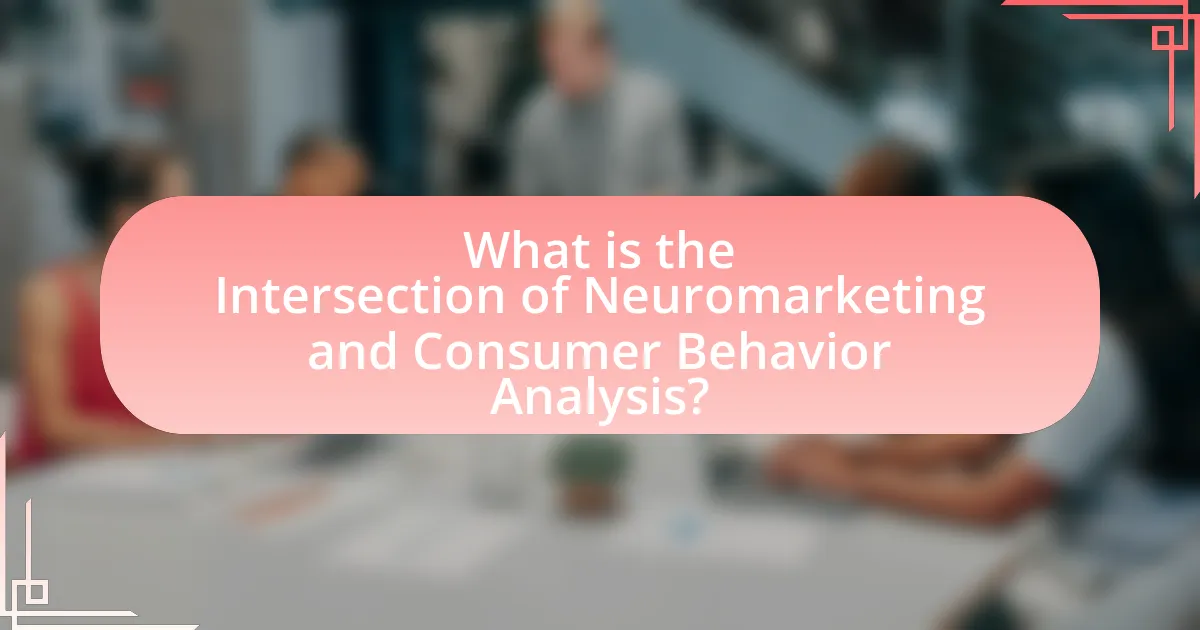The article examines the intersection of neuromarketing and consumer behavior analysis, highlighting how neuroscience techniques, such as fMRI and EEG, enhance the understanding of consumer decision-making processes. It discusses the relationship between these fields, emphasizing the importance of emotional and cognitive factors in shaping consumer preferences and behaviors. Key principles of neuromarketing, the role of biometric measures, and ethical considerations are explored, alongside the impact of consumer behavior analysis on marketing strategies. The article underscores the significance of integrating these disciplines to optimize marketing effectiveness and improve consumer engagement.

What is the Intersection of Neuromarketing and Consumer Behavior Analysis?
The intersection of neuromarketing and consumer behavior analysis lies in the application of neuroscience techniques to understand consumer decision-making processes. Neuromarketing utilizes tools such as fMRI and EEG to measure brain activity in response to marketing stimuli, providing insights into emotional and cognitive responses that traditional surveys may not capture. Research indicates that these insights can enhance marketing strategies by aligning them more closely with actual consumer preferences and behaviors, ultimately leading to more effective advertising and product development. For instance, a study published in the Journal of Consumer Research demonstrated that neuromarketing techniques could predict purchasing behavior with greater accuracy than conventional methods, validating the effectiveness of integrating neuroscience with consumer behavior analysis.
How do neuromarketing and consumer behavior analysis relate to each other?
Neuromarketing and consumer behavior analysis are interconnected as both fields aim to understand and predict consumer decision-making processes. Neuromarketing utilizes neuroscience techniques, such as brain imaging and biometric measurements, to gain insights into consumers’ subconscious reactions to marketing stimuli. This data complements consumer behavior analysis, which examines observable behaviors and psychological factors influencing purchasing decisions. For instance, a study published in the Journal of Consumer Research found that emotional responses measured through neuromarketing can significantly predict consumer preferences and choices, thereby validating the relationship between these two disciplines.
What are the key principles of neuromarketing?
The key principles of neuromarketing include understanding consumer emotions, leveraging subconscious influences, and utilizing brain imaging techniques to analyze decision-making processes. These principles are grounded in the idea that consumer behavior is often driven by emotional responses rather than rational thought. For instance, studies have shown that emotional advertising can significantly increase brand recall and purchase intent, as evidenced by research conducted by the Nielsen Company, which found that ads with emotional content performed twice as well as those with purely rational content. Additionally, neuromarketing employs tools like fMRI and EEG to observe brain activity, providing insights into how consumers react to marketing stimuli, thereby allowing brands to tailor their strategies effectively.
How does consumer behavior analysis inform marketing strategies?
Consumer behavior analysis informs marketing strategies by providing insights into how consumers make purchasing decisions, which allows marketers to tailor their approaches effectively. By understanding factors such as consumer preferences, motivations, and buying patterns, marketers can create targeted campaigns that resonate with specific audience segments. For instance, research from the Journal of Consumer Research indicates that emotional triggers significantly influence consumer choices, suggesting that marketing strategies incorporating emotional appeals can enhance engagement and conversion rates. Thus, leveraging consumer behavior analysis enables businesses to optimize their marketing efforts, leading to improved customer satisfaction and increased sales.
Why is understanding this intersection important for marketers?
Understanding the intersection of neuromarketing and consumer behavior analysis is crucial for marketers because it enables them to tailor strategies that resonate with consumers on a psychological level. This intersection provides insights into how consumers make decisions, influenced by emotional and cognitive factors, which can significantly enhance marketing effectiveness. Research indicates that neuromarketing techniques, such as brain imaging and biometric measurements, reveal subconscious responses to marketing stimuli, allowing marketers to optimize campaigns based on actual consumer reactions rather than self-reported data. For instance, a study published in the Journal of Consumer Research found that emotional engagement, as measured by neural activity, is a stronger predictor of purchasing behavior than traditional metrics. Thus, leveraging this intersection allows marketers to create more compelling and targeted marketing strategies that align with consumer motivations and behaviors.
What insights can neuromarketing provide about consumer decision-making?
Neuromarketing provides insights into consumer decision-making by revealing the subconscious processes that influence choices. Research indicates that emotional responses, measured through brain activity, significantly impact purchasing behavior; for instance, a study by Read Montague and colleagues demonstrated that neural responses to brand logos can predict consumer preferences before conscious awareness. Additionally, neuromarketing techniques, such as fMRI and EEG, allow marketers to understand how consumers react to advertisements, product designs, and pricing strategies, leading to more effective marketing campaigns. This understanding of the brain’s role in decision-making helps businesses tailor their strategies to align with consumer desires and motivations.
How can consumer behavior analysis enhance neuromarketing efforts?
Consumer behavior analysis enhances neuromarketing efforts by providing insights into the motivations, preferences, and decision-making processes of consumers. This analysis allows neuromarketers to tailor their strategies to align with consumer emotions and cognitive responses, leading to more effective marketing campaigns. For instance, studies have shown that understanding consumer behavior can improve the targeting of advertisements, as evidenced by a 2019 report from the Journal of Consumer Research, which found that campaigns designed with consumer insights resulted in a 30% increase in engagement rates. By integrating consumer behavior analysis, neuromarketing can leverage data on purchasing patterns and emotional triggers, ultimately optimizing the effectiveness of marketing initiatives.

What techniques are used in Neuromarketing?
Neuromarketing employs techniques such as functional Magnetic Resonance Imaging (fMRI), Electroencephalography (EEG), and eye-tracking to analyze consumer behavior. fMRI measures brain activity by detecting changes in blood flow, allowing researchers to understand emotional responses to marketing stimuli. EEG captures electrical activity in the brain, providing insights into cognitive processes and attention levels. Eye-tracking technology monitors where consumers look, revealing their interests and engagement with advertisements or products. These techniques collectively enhance the understanding of how consumers make decisions, enabling marketers to tailor strategies effectively.
How do neuroscientific methods apply to marketing research?
Neuroscientific methods apply to marketing research by utilizing techniques such as functional magnetic resonance imaging (fMRI) and electroencephalography (EEG) to analyze consumer brain activity in response to marketing stimuli. These methods provide insights into emotional and cognitive responses, enabling marketers to understand how consumers perceive brands, products, and advertisements. For instance, a study published in the Journal of Consumer Research demonstrated that fMRI can reveal which areas of the brain are activated when consumers view advertisements, indicating their level of engagement and emotional response. This data allows marketers to tailor their strategies to enhance consumer appeal and improve advertising effectiveness.
What role do brain imaging technologies play in neuromarketing?
Brain imaging technologies play a crucial role in neuromarketing by providing insights into consumer decision-making processes and emotional responses. These technologies, such as functional magnetic resonance imaging (fMRI) and electroencephalography (EEG), allow researchers to observe brain activity in real-time as consumers engage with marketing stimuli. For instance, studies have shown that fMRI can identify specific brain regions activated by advertisements, revealing how consumers emotionally connect with brands. This empirical evidence supports the effectiveness of neuromarketing strategies, as understanding neural responses can lead to more targeted and impactful marketing campaigns.
How do biometric measures contribute to understanding consumer responses?
Biometric measures significantly enhance the understanding of consumer responses by providing objective data on physiological reactions to stimuli. These measures, such as heart rate, skin conductance, and eye tracking, allow researchers to quantify emotional engagement and cognitive load during consumer interactions. For instance, a study published in the Journal of Consumer Research by Lutz and Kahn (2013) demonstrated that increased skin conductance correlated with heightened emotional arousal when participants viewed advertisements, indicating that biometric data can reveal underlying emotional states that traditional surveys may overlook. This objective insight into consumer behavior enables marketers to tailor strategies that resonate more effectively with target audiences.
What are the ethical considerations in neuromarketing?
Ethical considerations in neuromarketing include issues of consumer privacy, informed consent, and the potential for manipulation. Neuromarketing techniques often involve collecting sensitive data about consumers’ brain activity and emotional responses, raising concerns about how this information is used and whether consumers are adequately informed about the data collection process. For instance, studies have shown that consumers may not fully understand how their neurological data can influence marketing strategies, leading to ethical dilemmas regarding transparency and autonomy. Additionally, the risk of exploiting psychological vulnerabilities to drive purchasing decisions poses significant ethical challenges, as it can lead to consumer manipulation and erosion of trust in marketing practices.
How can marketers ensure consumer privacy while using neuromarketing techniques?
Marketers can ensure consumer privacy while using neuromarketing techniques by implementing strict data protection protocols and obtaining informed consent from participants. These protocols include anonymizing data to prevent identification of individuals and using secure data storage methods to protect sensitive information. Research indicates that 79% of consumers are concerned about how their data is used, highlighting the importance of transparency in neuromarketing practices. By clearly communicating the purpose of data collection and allowing consumers to opt-out, marketers can build trust and comply with privacy regulations such as GDPR.
What guidelines should be followed to maintain ethical standards in neuromarketing?
To maintain ethical standards in neuromarketing, practitioners should prioritize informed consent, transparency, and data privacy. Informed consent requires that participants are fully aware of the nature of the research and its potential impacts before agreeing to participate. Transparency involves clearly communicating the purpose of the neuromarketing study and how the data will be used, ensuring that consumers understand the implications of their participation. Data privacy mandates that researchers protect personal information and use it responsibly, adhering to regulations such as the General Data Protection Regulation (GDPR). These guidelines are essential to uphold consumer trust and integrity in neuromarketing practices.

How does Consumer Behavior Analysis enhance marketing strategies?
Consumer Behavior Analysis enhances marketing strategies by providing insights into customer preferences, motivations, and purchasing patterns. This analysis allows marketers to tailor their campaigns to meet the specific needs and desires of their target audience, resulting in more effective messaging and product offerings. For instance, a study by the American Marketing Association found that companies utilizing consumer behavior insights saw a 20% increase in customer engagement and a 15% boost in sales. By understanding how consumers think and behave, businesses can optimize their marketing efforts, leading to improved customer satisfaction and loyalty.
What are the key factors influencing consumer behavior?
Key factors influencing consumer behavior include psychological, social, cultural, and personal elements. Psychological factors encompass motivation, perception, learning, beliefs, and attitudes, which shape how consumers interpret information and make decisions. Social factors involve family, friends, and social networks that can affect preferences and choices. Cultural factors, such as values, traditions, and customs, significantly influence consumer habits and brand perceptions. Personal factors, including age, gender, income, occupation, and lifestyle, also play a crucial role in determining purchasing behavior. Research indicates that these factors interact dynamically, with studies showing that 70% of purchasing decisions are influenced by emotional and social factors, highlighting the complexity of consumer behavior.
How do psychological factors affect consumer purchasing decisions?
Psychological factors significantly influence consumer purchasing decisions by shaping perceptions, motivations, and behaviors. These factors include emotions, beliefs, attitudes, and social influences, which can drive consumers toward or away from specific products. For instance, a study published in the Journal of Consumer Research found that emotional responses to advertisements can lead to increased purchase intentions, demonstrating that positive emotions can enhance consumer engagement and decision-making. Additionally, cognitive biases, such as the anchoring effect, can alter how consumers evaluate prices and value, further impacting their purchasing choices. Thus, understanding these psychological elements is crucial for marketers aiming to effectively influence consumer behavior.
What role does social influence play in consumer behavior?
Social influence significantly shapes consumer behavior by affecting individuals’ purchasing decisions through social norms, peer pressure, and group dynamics. Research indicates that consumers are more likely to buy products endorsed by friends or family, as these social connections create a sense of trust and validation. For instance, a study published in the Journal of Consumer Research found that individuals are influenced by the opinions of their social circles, leading to increased likelihood of purchasing products that are popular within their networks. This demonstrates that social influence not only impacts what consumers buy but also how they perceive brands and products, ultimately guiding their choices in the marketplace.
How can data from consumer behavior analysis be utilized effectively?
Data from consumer behavior analysis can be utilized effectively by informing marketing strategies and product development. By analyzing purchasing patterns, preferences, and feedback, businesses can tailor their offerings to meet consumer needs more accurately. For instance, a study by McKinsey & Company found that companies using consumer insights to drive their marketing strategies can achieve a 10-20% increase in sales. This demonstrates that leveraging data not only enhances customer satisfaction but also boosts revenue, validating the effectiveness of data-driven decision-making in marketing and product innovation.
What tools and methods are available for analyzing consumer behavior data?
Tools and methods available for analyzing consumer behavior data include surveys, focus groups, web analytics, and neuromarketing techniques. Surveys gather quantitative data on consumer preferences and attitudes, while focus groups provide qualitative insights through group discussions. Web analytics tools, such as Google Analytics, track online behavior, revealing patterns in consumer interactions with websites. Neuromarketing techniques, including eye-tracking and EEG, measure physiological responses to marketing stimuli, offering deeper insights into subconscious consumer reactions. These methods collectively enhance understanding of consumer behavior, enabling businesses to tailor their strategies effectively.
How can businesses apply consumer behavior insights to improve marketing outcomes?
Businesses can apply consumer behavior insights to improve marketing outcomes by tailoring their strategies to align with the preferences and motivations of their target audience. For instance, understanding that 70% of consumers prefer personalized experiences allows businesses to create targeted marketing campaigns that resonate more effectively with individual consumers. By leveraging data analytics and neuromarketing techniques, companies can identify emotional triggers and decision-making processes, leading to more impactful messaging and product offerings. Research indicates that brands utilizing consumer behavior insights see a 20% increase in engagement rates, demonstrating the effectiveness of this approach in enhancing marketing performance.
What best practices should marketers follow when integrating neuromarketing and consumer behavior analysis?
Marketers should prioritize ethical considerations, data accuracy, and interdisciplinary collaboration when integrating neuromarketing and consumer behavior analysis. Ethical considerations ensure that consumer privacy is respected and that neuromarketing techniques do not manipulate consumers in harmful ways. Data accuracy is crucial, as reliable data from neuromarketing studies enhances the validity of consumer behavior insights. Interdisciplinary collaboration between neuroscientists, psychologists, and marketing professionals fosters a comprehensive understanding of consumer behavior, leading to more effective marketing strategies. For instance, a study published in the Journal of Consumer Research highlights that integrating neuroscience with traditional marketing research can significantly improve campaign effectiveness by aligning marketing messages with consumers’ subconscious preferences.


